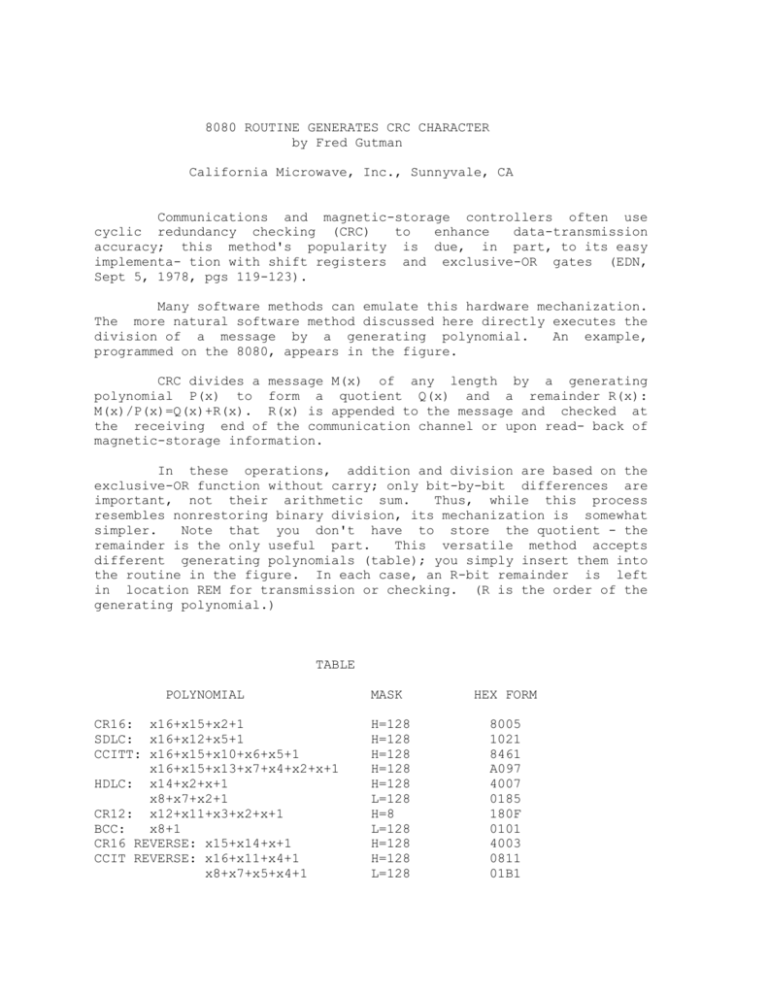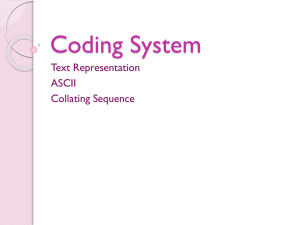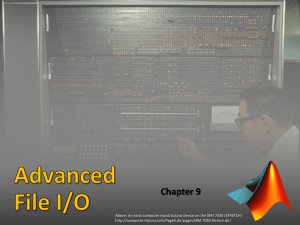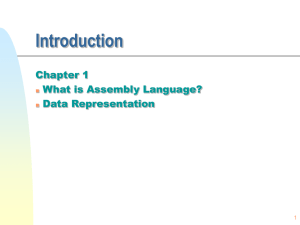8080 ROUTINE GENERATES CRC CHARACTER by Fred Gutman
advertisement

8080 ROUTINE GENERATES CRC CHARACTER by Fred Gutman California Microwave, Inc., Sunnyvale, CA Communications and magnetic-storage controllers often use cyclic redundancy checking (CRC) to enhance data-transmission accuracy; this method's popularity is due, in part, to its easy implementa- tion with shift registers and exclusive-OR gates (EDN, Sept 5, 1978, pgs 119-123). Many software methods can emulate this hardware mechanization. The more natural software method discussed here directly executes the division of a message by a generating polynomial. An example, programmed on the 8080, appears in the figure. CRC divides a message M(x) of any length by a generating polynomial P(x) to form a quotient Q(x) and a remainder R(x): M(x)/P(x)=Q(x)+R(x). R(x) is appended to the message and checked at the receiving end of the communication channel or upon read- back of magnetic-storage information. In these operations, addition and division are based on the exclusive-OR function without carry; only bit-by-bit differences are important, not their arithmetic sum. Thus, while this process resembles nonrestoring binary division, its mechanization is somewhat simpler. Note that you don't have to store the quotient - the remainder is the only useful part. This versatile method accepts different generating polynomials (table); you simply insert them into the routine in the figure. In each case, an R-bit remainder is left in location REM for transmission or checking. (R is the order of the generating polynomial.) TABLE POLYNOMIAL CR16: x16+x15+x2+1 SDLC: x16+x12+x5+1 CCITT: x16+x15+x10+x6+x5+1 x16+x15+x13+x7+x4+x2+x+1 HDLC: x14+x2+x+1 x8+x7+x2+1 CR12: x12+x11+x3+x2+x+1 BCC: x8+1 CR16 REVERSE: x15+x14+x+1 CCIT REVERSE: x16+x11+x4+1 x8+x7+x5+x4+1 MASK H=128 H=128 H=128 H=128 H=128 L=128 H=8 L=128 H=128 H=128 L=128 HEX FORM 8005 1021 8461 A097 4007 0185 180F 0101 4003 0811 01B1 -------------------------------------------------------------------NOTES FOR REPOSITORY USERS ON SIMTEL20 CRCs provide a convenient way to verify that a file received from a repository is an exact duplicate of the file on the repository. A standard CRC polynomial has been selected, and several different programs have been created which analyze files and compute the value of this CRC polynomial when the data in the file is provided as data for the polynomial. The following list may prove to be useful: Program Name -----------NCRC CRC CRC CRC Implementation Comments --------------------TOPS-20 MICRO:<CPM.TOPS20> NCRC.MID (written in Midas) UNIX PD:<UNIX.CPM> CRCK2.C (generic C) CP/M MICRO:<CPM.DIRUTL> CRCKxx.ASM (8080 asm) xx=version number ZCPR3 MICRO:<CPM.ZCPR3> CRC.MAC (8080 asm) Source code is provided for all of the routines listed above. The repositories on SIMTEL20 contain CRCLST files, generated by NCRC for TOPS-20, which contain the CRCs for the files contained in them. The <ADA> repository's CRCLST file is: PD:<ADA>ADA.CRCLST Previous versions of the CRCLST are often retained for historical purposes. Only the last N versions of ADA.CRCLST are retained, where N is indeterminant. By using the file reference specified above, the latest version is always retrieved. SAMPLE ADA.CRCLST Filename Type Bytes Directory PD:<ADA.COMPONENTS> LIMPRIOR.ADA.2 ASCII LIMPRIOR.PRO.2 ASCII LIST.ADA.2 ASCII 17483 Sectors 7374 3461 137 = CRC 58 = 3AH 364CH 28 = 1CH 813DH 89H 4B17H LIST.PRO.2 PRIOR.ADA.2 PRIOR.PRO.2 SAFEIO.ADA.2 SAFEIO.PRO.2 ASCII ASCII ASCII Directory PD:<ADA.GENERAL> 00READ.ME.2 ASCII ADAREPOS.TXT.2 COPYRITE.DOC.1 COPYRITE.INF.1 COPYRITE.TXT.1 FTP.DOC.1 ASCII LBR.DOC.2 ASCII MLIST.DOC.1 ASCII PROLOGUE.ADA.1 SAMPLE.PRO.1 UUCP-BIT.DOC.1 3397 6398 3582 ASCII ASCII 27 = 50 = 28 = 9730 3661 1578 13 = ASCII 3681 ASCII 4434 ASCII 5777 ASCII 11313 17412 137 = 955 8 = 807 7 = ASCII 2513 ASCII 3461 ASCII 4649 1BH 7780H 32H A562H 1CH 5060H 77 = 4DH 7E5BH 29 = 1DH BB29H DH 29 = 35 = 46 = 89 = 89H 8H 7H 20 = 28 = 37 = 84D1H 1DH 23H 2EH 59H B0E3H E967H 45FBH 14H 1CH 25H 9B3EH 206EH AEBCH 9916H 3CB9H 813DH CCBCH







